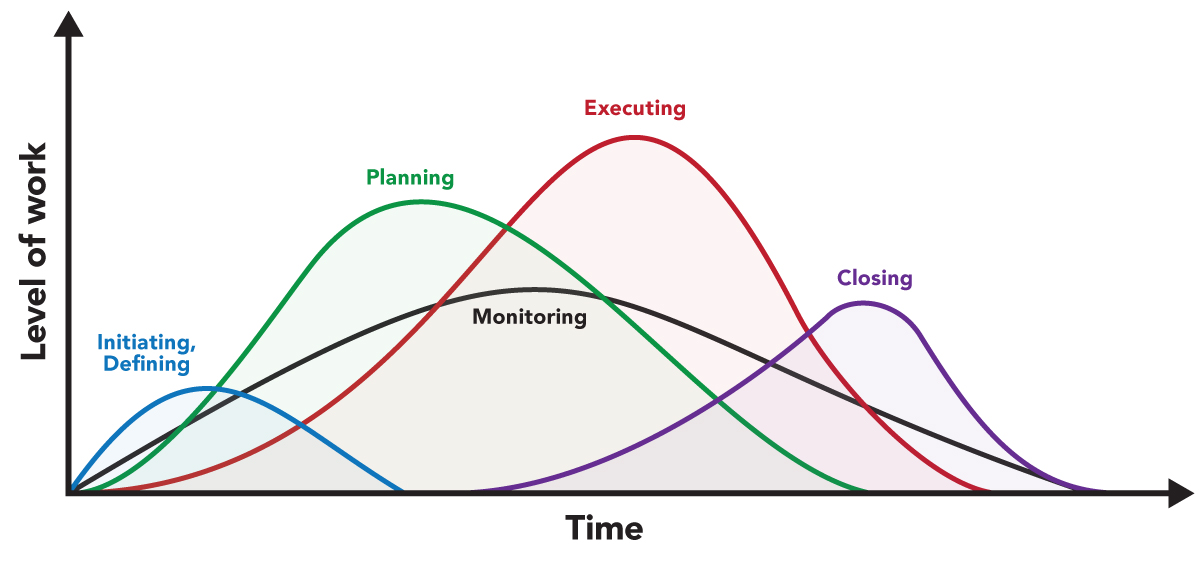1.5. Life Cycle
The project manager and project team have one shared goal: to carry out the work of the project for the purpose of meeting the project’s objectives. Every project has beginning and middle periods, during which activities move the project towards completion and an ending that is either successful or unsuccessful. A standard project typically has the following four major phases (each with its own agenda of tasks and issues): initiation, planning, implementation, and closure. Taken together, these phases represent the path a project takes from the beginning to its end and are generally referred to as the project’s “life cycle.”
A traditional project will go through different (overlapped) phases, while the monitoring process takes place continuously from the initiation phase to the closing phase. Monitoring her can be considered as a floating process required to ensure the alignment of the project processes with the project scope. During the life cycle, the execution phase will require the most effort from the project team and hence can be seen as the most productive phase (Figure 1.5).
Initiation Phase
During the first of these phases, the initiation phase, the project objective or need is identified; this can be a business problem or opportunity. An appropriate response to the need is documented in a business case with recommended solution options. A feasibility study is conducted to investigate whether each option addresses the project objective and a final recommended solution is determined. Issues of feasibility (“Can we do the project?”) and justification (“Should we do the project?”) are addressed.
Once the recommended solution is approved, a project is initiated to deliver the approved solution, and a project manager is appointed. Thereafter, the major deliverables and the participating work groups are identified, and the project team begins to take shape. Approval is then sought by the project manager to move on to the detailed planning phase.
Planning Phase
The next phase, the planning phase, is where the project solution is further developed in as much detail as possible and the steps necessary to meet the project’s objective are planned. In this step, the team identifies all of the work to be done. The project’s tasks and resource requirements are identified, along with the strategy for producing them. This is also referred to as “scope management.” A project plan is created outlining the activities, tasks, dependencies, and timeframes. The project manager coordinates the preparation of a project budget by providing cost estimates for the labour, equipment, and materials costs. The budget is used to monitor and control cost expenditures during project implementation.
Once the project team has identified the work, prepared the schedule, and estimated the costs, the three fundamental components of the planning process are complete. This is an excellent time to identify and try to deal with anything that might pose a threat to the successful completion of the project. This is called risk management. In risk management, “high-threat” potential problems are identified along with the action that is to be taken on each high-threat potential problem, either to reduce the probability that the problem will occur or to reduce the impact on the project if it does occur. This is also a good time to identify all project stakeholders and establish a communication plan describing the information needed and the delivery method to be used to keep the stakeholders informed.
Finally, you will want to document a quality plan, providing quality targets, assurance, and control measures, along with an acceptance plan, listing the criteria to be met to gain customer acceptance. At this point, the project would have been planned in detail and is ready to be executed.

Implementation (Execution) Phase
During the third phase, the implementation phase, the project plan is put into motion and the work of the project is performed. It is important to maintain control and communicate as needed during implementation. Progress is continuously monitored and appropriate adjustments are made and recorded as variances from the original plan. In any project, a project manager spends most of the time in this step. During project implementation, people are carrying out the tasks, and progress information is being reported through regular team meetings. The project manager uses this information to maintain control over the direction of the project by comparing the progress reports with the project plan to measure the performance of the project activities and take corrective action as needed. The first course of action should always be to bring the project back on course (i.e., to return it to the original plan). If that cannot happen, the team should record variations from the original plan and record and publish modifications to the plan. Throughout this step, project sponsors and other key stakeholders should be kept informed of the project’s status according to the agreed-on frequency and format of communication. The plan should be updated and published on a regular basis.
Status reports should always emphasize the anticipated endpoint in terms of cost, schedule, and quality of deliverables. Each project deliverable produced should be reviewed for quality and measured against the acceptance criteria. Once all of the deliverables have been produced and the customer has accepted the final solution, the project is ready for closure.
Closing Phase
During the final closure or completion phase, the emphasis is on releasing the final deliverables to the customer, handing over project documentation to the business, terminating supplier contracts, releasing project resources, and communicating the closure of the project to all stakeholders. The last remaining step is to conduct lessons-learned studies to examine what went well and what didn’t. Through this type of analysis, the wisdom of experience is transferred back to the project organization, which will help future project teams.

“1.2: Project Management Life Cycles and Processes” from Project Management Fundamentals by J Scott Christianson is licensed under a Creative Commons Attribution-NonCommercial-ShareAlike 4.0 International License.
“3. The Project Life Cycle (Phases)” from Project Management – 2nd Edition by Adrienne Watt; Merrie Barron; and Andrew Barron is licensed under a Creative Commons Attribution-NonCommercial-ShareAlike 4.0 International License, except where otherwise noted.

